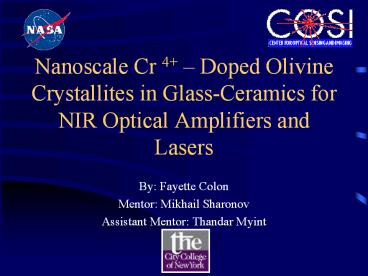Nanoscale Cr 4 - PowerPoint PPT Presentation
1 / 19
Title: Nanoscale Cr 4
1
Nanoscale Cr 4 Doped Olivine Crystallites in
Glass-Ceramics for NIR Optical Amplifiers and
Lasers
- By Fayette Colon
- Mentor Mikhail Sharonov
- Assistant Mentor Thandar Myint
2
Abstract
- The purpose of this experiment is to fabricate
- Cr 4 ion doped laser crystals and
characterize glass ceramics containing nanoscale
crystallites of Cr 4 - doped laser materials
such as Cr 4 Mg2SiO4 and Cr 4 Ca2GeO4. The
glass ceramic is important because it can be used
in several applications such as the fiber
amplifier, fiber laser and for other medical
purposes.
3
Objectives
- Material preparation
- To uncover a proper host for the Cr 4 ion
through the research of the LiInSiO4 and CaSiO4
systems. - Optical characterization of materials
- To compare a glass ceramic doped with
nanocrystallite Cr4 ions and bulk laser
crystals, - such as Cr 4 Mg2SiO4 or Cr4 Ca2GeO4 to
observe whether it has the same characteristics
as the individual bulk crystals.
4
What is a laser?
- It is an acronym for Light Amplification by the
Stimulated Emission of Radiation - A laser produces near- monochromatic light
- Has a single precise wavelength or hue
- The light is coherent
- The photons emitted have a definite phase
relationship - Laser beams are collimated
- They are narrow and concentrated
5
Electronics to Support Synchronization Between
the Lasers
The circuit used two non-inverting operational
amplifiers In a non-inverting input the output
polarity is the same as the input polarity
6
Laser System
Thandar Myint
7
Importance of the Circuit
- The circuit serves as a component to the laser
system - It is designed to aid in synchronizing the pump
and the signal pulses in order to reach the laser
amplifier at the same time.
8
Raman Measurement
9
Spectrometer/ Detector
- A Spectrometer is an optical instrument which
measures the properties of light over a portion
of the electromagnetic spectrum. The measured
variable is often the intensity and the
independent variable is the wavelength.
- A Detector is a device which is designed to
detect the presence of something as well as to
emit a signal in response.
10
Experimental Set Up
F. Colon
11
Experimental Information
- A HeNe laser was used it generates a 632.3nm
laser line and its power is about 1mW. - The light passed through a filter (which
selectively transmits certain portion of light)
then reflected onto a mirror at 45 degrees - The light beam then reflected onto a second
mirror and through a second filter - The laser was again reflected onto a mirror
through a lens (which is 12cm from the crystal)
to be reflected on a fourth mirror and into the
glass ceramic crystal - The light then scattered and was collected by a
Camera Lens following which it went into the
Spectrometer. - The Camera Lens must be finely adjusted to
receive good focusing
12
(No Transcript)
13
(No Transcript)
14
Results
15
Further Results
16
Analysis of the Results
- The graph shows the light intensity versus
wavelength of HeNe laser. - The maximum power of the HeNe laser is located at
632.8nm. - The shape of the image is well-known Gaussian
shape, which means that the intensity is
concentrated in the center and gradually
decreases at the tails. - Although this was merely a test trial for the
experiment its importance lies with the layout of
the experimental instruments.
17
Further Work
- The Research team will use the results of the
test trial to create a more efficient layout for
the experiment. - Following which the high intensity laser will be
used for the actual experiment along with the
circuit created - Completion of this experiment is important
because the data received will show the
characteristics of the glass ceramic obtaining
this knowledge will lead to realize the proposed
application such as optical amplifiers.
18
Acknowledgements
- Mentors Mikhail Sharnovo and Thandar Myint
- NASA SHARP
- NASA COSI and DoD NPC Summer Program
- City College of New York
- CREST CMMS
- NYC-MTA
19
References
- Characteristics of Laser Light
- http//en.wikipedia.org
- What is a Laser?
- http//en.wikipedia.org
- Detector
- http//en.wikipedia.org

